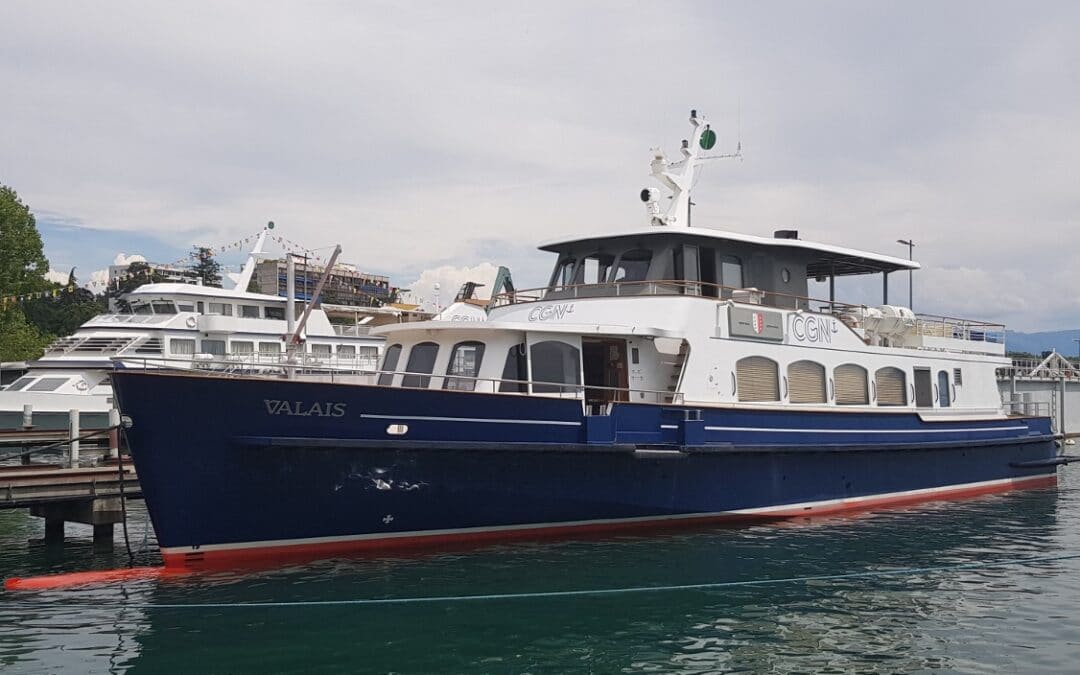Energy-saving retrofits are commonplace on large cargo vessels and cruise ships. But can an energy-saving retrofit also make a significant difference on a small passenger vessel? Swiss ship owner CGN, which operates a fleet of 19 passenger ships on Lake Geneva, decided to find out. As a test case, they chose the 30m passenger vessel Valais, which was built in 2008, and which services their N3 line, connecting Yvoire (France) to Nyon (Switzerland) by up to 40 crossings a day. The answer is a clear yes.
Optimisation
Irwin Gafner, technical director of CGN says: “We selected the 30m passenger ship Valais and commissioned a ship optimisation study by means of Computational Fluid Dynamics software, comparing several possible hydrodynamic improvements at our operating speed of 25 km/h. In the study, the benchmark hull (which has a trim wedge) was compared to various retrofit alternatives for the stern, such as ducktail extensions, interceptors (a vertical blade protruding below the transom) and a Hull Vane®, which is a rather novel solution and can be described as a “spoiler for ships”. The best alternative to come out of this optimisation was the Hull Vane®, promising a resistance reduction of 15%. We also asked to optimise a bulbous bow for the ship with Hull Vane®.
Construction
After the hydrodynamic study, CGN Technique ordered the Hull Vane® from Hull Vane B.V. and the bulbous bow from a local subcontractor. Lake trials were performed before dry docking, in which accurate measurements were made of the ship’s fuel consumption. During the scheduled dry dock period, at the CGN Technique facilities in Lausanne, both devices were installed, and the main engines were replaced with new common-rail V8 MAN engines. After launching of the vessel, ballast was added in the bow to bring the ship to the appropriate draught.
24% saving
In spite of the significant amount of added weight, including Hull Vane®, bulbous bow construction and ballast, the results showed that the fuel consumption of the vessel was reduced by 24%. Noise measurements on board also showed that the improved efficiency, lower rpm’s and new engines made the vessel quieter: the noise level was reduced by 2 dB(A) in the wheelhouse and by 6 dB(A) in the passenger lounge. The vessel now also makes significantly less waves, a fact which is appreciated by the recreational users of Lake Geneva. The added weight and added submerged surfaces also improve the stability and seakeeping of the vessel.
Demo boat
Bruno Bouckaert, sales director of Hull Vane BV: “There are a lot of small passenger ships ranging from 20 to 100m in use worldwide, on rivers, lakes and servicing islands. Because of their length and displacement, they often operate at excellent speeds for Hull Vane® effectiveness, making a retrofit very worthwhile. We are very happy that CGN took this pioneering step. Having a Hull Vane® on a passenger ship also makes it a lot easier for us to show clients how simple and effective the device really is. MS Valais is the ideal demo boat, as we can simply buy a ticket and make a crossing on board.
129 tons of CO2
Irwin Gafner (CGN): “We are extremely pleased with the results of this retrofit. Improving the hydrodynamics of a vessel makes perfect sense, regardless of which fuel we will be using in the future. Using less fuel makes a future energy transition easier and more affordable, and in the meantime, we have the benefit of lower fuel costs, less CO2 emissions, less noise and less waves. Coming from an automotive background, I am amazed at the savings percentages which are still possible on passenger ships. There is a huge untapped potential for CO2 reduction on ships, it is very low-hanging fruit. We have calculated that this retrofit on MS Valais will reduce CO2 emissions by 129 tons per year, and of course also 24% of diesel particles and NOx emissions. Last but not least, the return on investment is excellent.”
